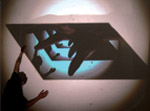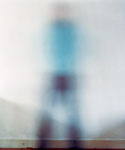presents |
|
||||||
| Krowswork Gallery is pleased to present Time(Lapse), an exhibition featuring photography, video, and installation by Drone Dungeon, Katja Mater, Kim Miskowicz, and Liena Vayzman. Each of these artists is exploring image degradation through manipulated or natural cycles of time, echoing yet ultimately breaking with the sequential and linear clarity charted by photographer Eadweard Muybridge’s famous “Motion Studies” in favor of a restructuring of narrative and an emphasis on the complexity of the whole. In 1878 Eadweard Muybridge made history by capturing sequential photographs of individual intervals of a horse in motion. By thwarting time in such dramatic fashion, Muybridge positioned himself at the frontier of the moving image,* and his photographs seem inseparable from the very trajectory of history he foretold: one in which cutting edge technology would be able to decipher processes that had been up till then literally a blur. But now, in 2010, it must be admitted that the clarity that trajectory portended may not be the actual end result at all. |
While the artists in this exhibition do not profess to be answering to Muybridge, their specific explorations of time and motion in a photographic medium answer to Muybridge’s experiments 130 years ago, and in some ways their approaches can be viewed as both as a critique and a continuation of the paradigm he initiated. Each of them is working to overlap and condense accumulated motion and time into singular imagery—an effort that purposely nullifies the sequential rationale of the original motion studies and obscures the very intelligibility Muybridge was seeking through them. Yet these artists, like their 19th-century predecessor, are very much in step with the psychic demands of their time, which today require that information be processed faster, that natural cycles previously thought untouchable be understood as manipulable by man and his technology, that linear narrative be treated as suspect, and that uncertainty, not clarity, rule the day. *This reading of Muybridge’s significance is informed by Rebecca Solnit’s amazing 2003 book on this subject, River of Shadows: Eadweard Muybridge and the Technological Wild West. |
||||||
 |
Drone Dungeon, an evolving collective from San Francisco, whose participants at Krowswork include Hunter Longe and Dietrich Kleffel, are in the project room, with an installation in which the very clarity and order of the imagery is determined by triggering sensors placed in the project space. Unlike the tripwire sensors that Muybridge used to elucidate sequence, the sensors in this project, when tripped, cause the video to resequence itself at random, and any attempts at reading meaning through narrative are rendered literally inconsequential. Instead the viewers must adjust their voyeuristic expectations and understand they are integral to the work’s meaning. |
 |
Katja Mater, a visual artist from Amsterdam, works both conceptually and intuitively in the medium of photography. In a recent interview she described her process: she combines many exposures and develops them into a single image, which allows her to make “visible [those things] that are never visible in ‘real time’ and space, or at least not perceivable with the human eye. This makes the moment that a picture is taken somehow a portal to a parallel dimension in which time has a total other function then in ours.” Certainly this approach is heir to Muybridge, yet the resulting images are palimpsests of all that the forms that have taken place in that space over varying times, and the result is striking, purposeful illegibility that alludes to an entirely other conception of time. |
||||
 |
Kim Miskowicz calls her video work “moving images” – a throwback to a more encompassing, even romantic, vocabulary, when the fact of these being single frames of pictures was the most relevant factor to our understanding of the whole. Miskowicz, in fact, is obsessed with compositional subtleties of individual photographs taken within a short sequence of time. Her “moving images” involve individual photographs scanned onto a computer or reshot through a camera, or shots extracted through multiple formats and generations. The resulting videos imply a natural movement, but this movement is often simulated: it doesn’t exist except by her crafting it together. Through this fabricated motion she pointedly seeks to diminish the intelligibility of the initial photo or footage, leaving instead nostalgic traces of a time that never was. |
|
Liena Vayzman presents The Lemon Tree project, a study that took place over the course of 365 days, during which Vayzman studied the accumulation and decay of lemons from the lemon tree in her backyard. The tangible residue is a series of 10 photographs, which show these bright yellow objects as they rotted becoming green, blue, purple, shriveled, warped, depleted, and then nonexistent. Like Muybridge, Vayzman is capturing motion through time in photographs, but Vayzman has taken this experiment to a temporal extreme and embraced the entire cycle of change, including the ultimate entropy it entails. |
||||
|
|||||||
|
|||||||
